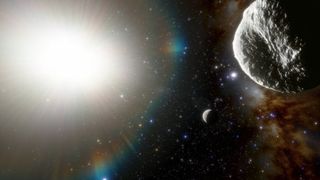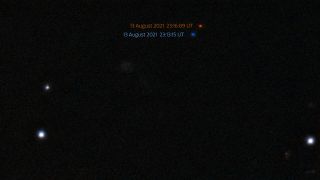
A newfound asteroid zips around the sun faster than any of its known kin.
The space rock, known as 2021 PH27, completes one lap around our star every 113 Earth days, its discoverers determined. That's the shortest orbital period of any known solar system object except the planet Mercury, which takes just 88 days to loop around the sun.
However, 2021 PH27 travels on a much more elliptical path than Mercury does and therefore gets considerably closer to the sun — about 12.4 million miles (20 million kilometers) at closest approach, compared to 29 million miles (47 million km) for the solar system's innermost planet.
Related: The 7 strangest asteroids in the solar system
During those close solar passes, 2021 PH27's surface gets hot enough to melt lead — about 900 degrees Fahrenheit (500 degrees Celsius), the discovery team estimates. Those deep dips into the sun's gravity well also mean the asteroid experiences the largest general relativity effects of any known solar system object. Such effects manifest as a slight wobble in 2021 PH27's elliptical orbit around the sun, which the team has observed.
That orbit, by the way, is not stable over the long haul. 2021 PH27 will likely collide with the sun, Mercury or Venus a few million years from now, if it's not ejected from its current path by a gravitational interaction first, team members said.
2021 PH27 was first spotted on Aug. 13 by astronomers using the Dark Energy Camera (DEC), a powerful multipurpose instrument mounted on the Víctor M. Blanco 4-meter Telescope at the Cerro Tololo Inter-American Observatory in Chile.
Sign up for the Live Science daily newsletter now
Get the world’s most fascinating discoveries delivered straight to your inbox.
The team was able to pin down the asteroid's orbit over the next few days, thanks to further observations by the DEC and the Magellan Telescopes at the Las Campanas Observatory in Chile, as well as smaller scopes in Chile and South Africa operated by the Las Cumbres Observatory.
The 2021 PH27 push postponed some scheduled observations with those instruments, but the reshuffling was worth it, team members said.
"Though telescope time for astronomers is very precious, the international nature and love of the unknown make astronomers very willing to override their own science and observations to follow up new, interesting discoveries like this," discovery team leader Scott Sheppard, an astronomer at the Carnegie Institution for Science in Washington, D.C., said in a statement.

Sheppard and his colleagues estimate that 2021 PH27 is about 0.6 miles (1 km) wide. The space rock may have originated in the main asteroid belt between Mars and Jupiter, then gotten kicked inward by gravitational interactions with one or more planets, the researchers say.
However, 2021 PH27's orbital path is tilted by 32 degrees relative to the plane of the solar system. Such a high inclination suggests it might instead be an extinct comet that was born in the far outer solar system, then captured into a closer orbit after passing by Mars, Earth or another rocky planet.
Further observations could help resolve this mystery, but Sheppard and other astronomers will have to wait a few months to collect more data. 2021 PH27 is now moving behind the sun from our point of view, and it won't re-emerge until early 2022, discovery team members said.
Mike Wall is the author of "Out There" (Grand Central Publishing, 2018; illustrated by Karl Tate), a book about the search for alien life. Follow him on Twitter @michaeldwall. Follow us on Twitter @Spacedotcom or Facebook.

Most Popular



